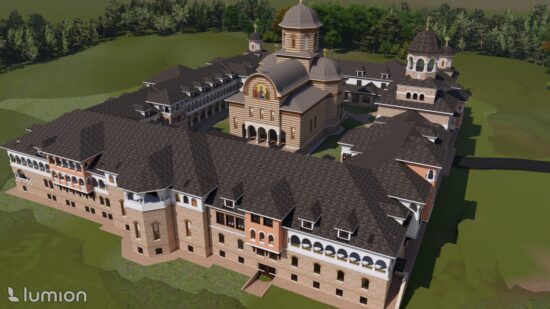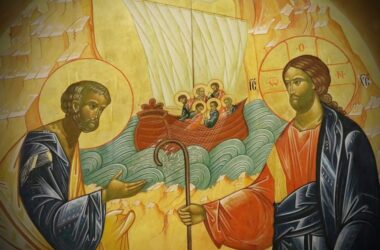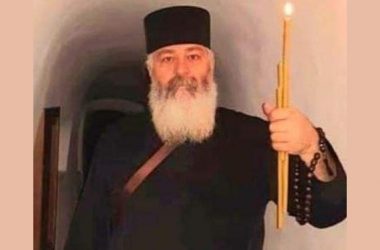Many people have wondered why another monastery and why Saint Neagoe Basarab was chosen as its patron saint. What exact essence, what breath, what voice, what power overcame worldly, often of mercantile logic, fickle, full of “rational” arguments, especially in opposition to the evident work that Christ does through His Saints? For this reason, we deemed it appropriate to write a few lines to shed light on those who still wonder or doubt.
As attested by the old documents of the Holy Mountain, which can be researched in nearly all Athonite monasteries, as well as the hermitages and chapels that bear witness over the centuries to the donations and blessings that Saint Neagoe bestowed upon the Garden of the Mother of God, we likewise deemed it fitting, through the intercession of the Saint and by the will of the Lord, that it is now Athos’s turn, as a sign of gratitude and appreciation, to dedicate a monastery to this great Orthodox and Romanian Voivode Saint. As the great Iorga said: “A people who do not know their history is like a child who does not know its parents.” And how could we build a future without knowing the coordinates of the past of a people molded from the clay from which their ancestors were born, were children, and became the perfected men of their forebears?! And perhaps this Orthodox people would mean nothing to the world if history itself did not cry out, like stones in the streets, about the worthiness and skill, the decency, humility, and wisdom that this people received as gifts to defend what may be holiest to them: Christ and the soul. This is how a people honor its ancestors from whom it received faith, language, and ethos.
The idea was formulated fifteen years ago, and it was then that a request for blessing to build a small church dedicated to Saint Neagoe was submitted to the Monastery of Saint Paul. At that time, the project could not be realized, and we believe it was the will of the Saint and the Mother of God that this monastery to be built on the land from which Saint Neagoe was born, the Romanian land. The pandemic context also contributed to this decision, as the need for a place of retreat in the native land arose due to uncertain times. Even though geographically the location has changed, spiritually the monastery will adhere to Athonite tradition and rituals, further strengthening the bond between Mount Athos, so blessed by the Saint Voivode, and the faithful people.
This is how we proceeded to present to His Eminence Calinic the desire of Lacu Skete to establish a monastery, and His Grace suggested that this monastery be dedicated to Saint Neagoe, especially since, appealing to morality, Saint Neagoe did not receive the reverence due to his lofty spiritual stature, acquired under the guidance of Saint Niphon, the Patriarch of Constantinople, who was his spiritual father. Therefore, the Saint remained in history as the hermit prince. At the same time, we consider that a place dedicated to Saint Neagoe serves as a moral reparation throughout the centuries, as during the few years of his reign, he did not linger in deeds, being the protector of the entire Orthodox world, then under pagan rule.
The architecture will consist of intertwining the Brâncovenesc style with the Athonite style – an architectural metaphor meant to unite and refine the harshness of hesychastic life with princely refinement, similar to the spiritual structure of Saint Neagoe. A purely technical description of the monastic ensemble would be this: besides the main courtyard, where both female and male believers will have access, there will be an Avaton, a place where only monks will have access, as a place of tranquility and retreat, envisioned as being located behind the monastery.
There will be no electricity in the church, and services will be held by candlelight, following the Athonite tradition. Additionally, the monastery’s rule will be Athonite, as mentioned above: monastic life will be like in Mount Athos, with perfect obedience.
And as nothing is accomplished without the will of God, I felt this call to establish a monastery as a command received from the hand of the Lord, because Saint Neagoe, through his life and deeds, gained great favor with God, and we believe it was also the desire of the Saint to have a monastery built in his honor, so that through this many people may find comfort and help in times of need.
And if there are voices that contest this project, citing turbulent times, history itself bears witness that man has almost always lived through challenging times, according to the plan of the Almighty. Despite all turmoil, poverty, and need, despite all wars, our ancestors fulfilled their calling to pass down the holy faith to their descendants, building Altars where the Eucharist would rest in the Holy Chalice for a people communed through sacrifice and tears. How will we, the people of today, not feel ashamed when we meet our ancestors and forefathers, in front of whom we will have no answers? If we dare to say that the times were not on our side, the soldiers of Voivode Mircea, the peasants of Saint Stephen, the warriors of Mărășești will all shame us, because their ultimate gesture of gratitude for battles won and help received from Christ and the Mother of God was the building of an Altar, out of their meager resources and poverty. And us? What will we leave behind?
We have a moral and spiritual duty to ferment the dough from which those who come after us will be molded: to be their role models, to teach them that the most valuable structures are built with much sacrifice and hard work. It is not abundance that sanctifies, but love. Let us be careful not to become adversaries of the Lord’s will and not to turn our backs on the high calling to build an Altar where we may humbly bow our knees.
Instead of an epilogue, let us heed the words of the Protos of the Holy Mountain at that time, Gabriel Protul (who led the Athonite delegation that came to consecrate the Monastery of Argeș), who bears witness to his sanctity: “What shall we say about the things and monasteries he endowed? … And in all directions from East to West he sustained all the Holy Churches and everywhere showed great mercy. And he was not only good to Christians, but also to pagans, and was a merciful father to all, resembling the Heavenly Lord, who shines His sun and rain upon both the good and the evil, as the Holy Gospel shows.”
Let us pray to the Mother of God to cover us with the Holy Veil, and let Saint Neagoe intercede for us, giving us the strength to perform good deeds. Amen!






